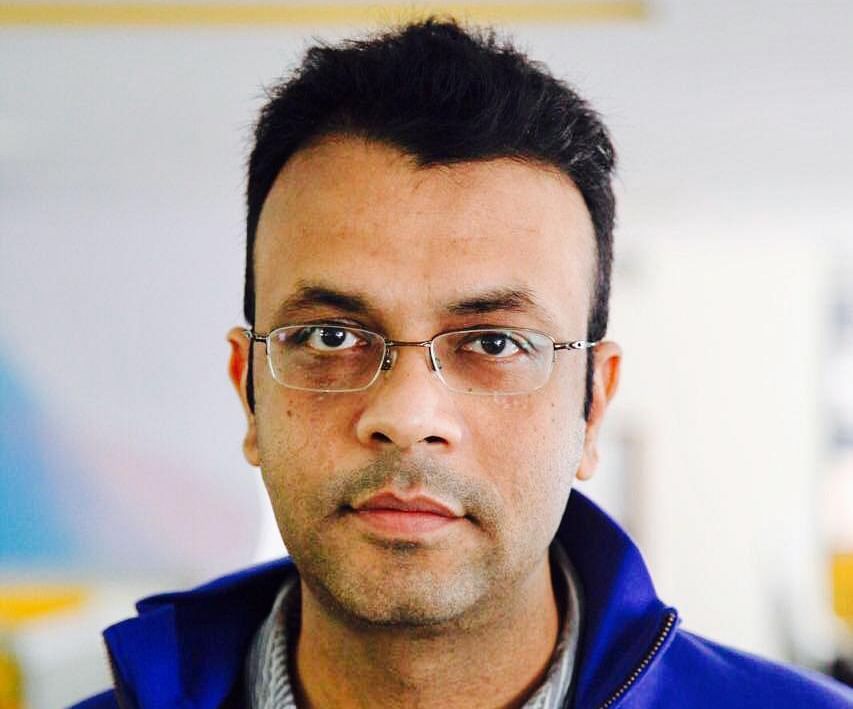Deepak Abbot is rather well-known in the startup world of product and growth hacking. The co-founder of indiagold, Deepak has been the Senior VP - Products at Paytm, COO of Getsmart, and Zapak’s CPO.
Having built several web-based products from scratch, Deepak is known to have taken several core products to scale.
In a conversation with YourStory, Deepak explains the importance of product thinking and why is it the focus word in our industry. He shares his experiences and lessons of building products to scale.
Editec excerpts from the interview:
YourStory (YS): Why is product thinking key for any startup, whether in the early or the later stages?
Deepak Abbot (DA): The way we define startups is that they are either trying to disrupt an existing model or creating something new. Most of it is four or five-year plan and these things are vague, and that is true even for a unicorn like Paytm that is thinking four to five years ahead.
The only way is to keep experimenting. To achieve that, you hire smart people who know what they’re doing, understand the target audience, understand the market, and take baby steps. These steps create something like a piece of code, a service, an app, a website – which build towards your goal. It is the product person who is going to transform the vision of the business person, techie, or the founder to something that the end-user can use.
Thus, nothing works without a product in the startup world. Now, in the digital world, the definition of a product is different from a manufacturing company or a services company.
In the startup world, the product is defined as the platform that we create for the end consumer to experience something that they may not have, or they may not have experienced in the same fashion.
With companies like Beardo, which are technically like traditional FMCG companies when we look at the product, their approach to consumer acquisition, branding, and distribution mediums were all different. They created an experience layer between the product and at the consumer. Thus, their definition of the product would be the experience they are creating for the consumer.

Deepak Abbot
YS: How do you work on building the MVP for products that will keep transforming and changing? How do you approach them?
DA: While the definition of an MVP is a Minimum Viable Product, it depends on which segment you’re building it for and what’s your competition. If I am building a CRM, Helpdesk software, or an analytics tool, then I can’t simply just build an MVP because there are 10 established companies which can build great products and my MVP won’t have a chance, and the end customer now has certain expectations. They want things that are already available in the market, so you need to build better than that.
YS: What about your personal learnings? How do you approach building for indiagold?
DA: Many people in India buy and take gold offline. They go to an outlet, which could be an organised player or a pawn jewellery shop.
Now, we want to build this entire experience online, but having said that, if we build the entire journey based on how a consumer feels while shopping for gold offline versus doing so online, it might take me several months to a year to replicate the same experience.
As with gold shopping, nobody looks at one piece and buys it. They look at multiple pieces and then buy. So I may have to build that VR experience to replicate an offline experience. Can I show them how a particular piece of jewellery will look on them? Can I give them a full surety that I am a legitimate outlet where I sell original gold with guarantees behind it?
YS: How do you bring a shift in consumer behaviour with your product?
DA: Now, as a startup, you can’t take a big billboard or run a TVC to build the brand. So you first need to make people get comfortable to buy gold online. So I realised that the easiest way to give them an online experience was to sell something as low as Re 1.
Digital Gold that I sell for Re 1 becomes an MVP to selling real gold online. Now you come online and buy gold - real 24 Carat gold for Re 1 or Rs 10 and see how it feels owning gold. You may not get the delivery, we slowly build an assurance that tomorrow, when you keep adding the amount up to Rs 2,200 (depending on your saving capabilities), we will ship you 0.5 grams of 24 Carat gold.
This may not be much but we are building a certain trust and comfort with the idea of buying gold online. We have been in this for 15 years, so we believe that maybe in five years, people will stop buying physical jewellery and will buy gold for savings and insurance. So the question is – how do I keep changing that behaviour towards owning physical goods?
Can we get people who are safekeeping gold at their homes and not possibly wearing it? Or keep it in a government-approved system and own a certificate that they own x amount of gold and when the value of that gold appreciates, they get the benefit? And tomorrow if they want to get the gold, they can get the gold they want of the same quantity. It may not be of the same form they submitted, but they are the owner of a certain quantity.
These are fundamental behaviour changes and it will take several years. So the MVP focuses on whether they buy digital gold for Re 1. Build a small buy/sell experience, and give them an experience of gold loans online. These steps, when consistently built, give the confidence that digital gold is as viable as physical gold.
YS: While you are building a product with a larger vision to be fulfilled in a few years, how do you account for user feedback?
DA: Take the gold loan example: you generally go to a store with your gold, the store managers take the gold and check it for quality and purity, and they transfer the money. And when you repay, you take the gold back. If I have to change this behaviour – then I need to ask if I can go to the consumer's house, do the exchange in front of them and if they like the price, they get the money in five minutes.
There are many steps involved. How will I know how users will react to the whole procedure? Some people just call to check the value of the gold. Instead of building the entire tech experience on the app where they can order the person to come in and go the extra mile, can I have a simple form in my app asking if they want their gold valued by our experts? And then, we send someone in.
Building an extensive app doesn't always work. Can it be done one-on-one to understand their needs – do they want more money, lesser interest rate, lesser tenure? What are they thinking? For that, you don’t need tech. You need people who attend to real consumer needs.
Start with a basic service, understand their psyche and then hire and work on the complex steps of building the product.
YS: What mistakes do product people make?
DA: One of the biggest mistakes we make is believing that what a customer is saying is what they actually want. You need to understand that the customer is telling a problem and while they may say they want something, the solution will not come from them.
A customer, for example, will tell you that they want a juicer that can make pineapple juice without peeling it. You will create some complex mixer that does that but it is pointless. What the customer is actually asking for is a hassle-free and fast way to drink pineapple juice. They actually are telling you – I don’t want too many hassles when I want a pineapple juice made freshly at home. So the idea is to simplify the problem statement and look at the solutions.
Listen to the first 10 customers, understand the core problem and then see the simplest way of solving that. The product must be an extendable solution to a few other things they may do.
Cut the problem into multiple chunks and that’s the easiest way to solve. Maximise the coverage area you can get with a product and keep building on that. There is no single product that can cater to every single need of every person.
Even something like WhatsApp has 96 percent retention, there still are 4 percent people who don’t find its use.
YS: How do you build products that are completely ubiquitous and have high retention?
DA: All products with a cult status have two things that work for them – network effects and word of mouth. Products like WhatsApp and Facebook created a network effect where people started talking about the ease of use through friends and word of mouth.
Any product that gets these two things right will have a cult status. Even if one is missing they won’t have the standing.
For example, while Ola and Uber have word of mouth, they still aren’t used by 96 percent market share. It doesn’t have a network effect. If I am travelling on an Uber or Ola, it doesn’t mean my friends also will do so, unlike WhatsApp.
Today, with hindsight vision, we may say WhatsApp is easy to use. But if you think back, the network effects were strong. Your friends had it so you had it, and you were on it so you got your parents and siblings on it. And of course, the product was simple that reachd people within two taps.
YS: How do you bring in network effects and word of mouth for your product?
DA: When I am building a product, I need to think of three things – will it help me? By using this product, can I also help people around me? And by telling people about this product, will I look ‘cool’? All the Silicon Valley products work on this model where they make you feel ‘cool’ about using the product and you start doing word of mouth. You look like an early user and a cool person.
For example, the reason Shareit became popular was that people were sharing illegal videos and music on it. People realised how easy it was to share videos without going to clunky sites with malware. So when a young person tells their friends, your coolness factor increases. And it also has a usefulness factor.
Then the word of mouth kicks in, where the initial person gets rewarded. For example, Dropbox said if you get your friend, you get 2GB extra space and the more friends means more space for free.
You also can create scarcity like how Facebook and Gmail did with the invite-only option. It creates excitement.
For Indian products, I think we still have a strong belief that western products are cooler and better. You think you look cooler when you use a product that is made in the US; that is why Americans get more love in India.
Also, anyone in India who has built great engineering products caters to consumers outside India. They end up building globally-focused products.
YS: What advice would you like to give product developers?
DA: The only quality a product manager should have is the ability to ask a lot of questions and just be curious. You will learn a lot when you’re curious and apply that learning in a way, which translates into something that is easy to use.
Edited by Kanishk Singh
India’s most prolific entrepreneurship conference TechSparks is back! With it comes an opportunity for early-stage startups to scale and succeed. Apply for Tech30 and get a chance to get funding of up to Rs 50 lakh and pitch to top investors live online.
Link : https://yourstory.com/2020/10/ys-learn-deepak-abbot-indiagold-paytm-product-thinking-startups
Author :- Sindhu Kashyaap ( )
October 12, 2020 at 05:50AM
YourStory




